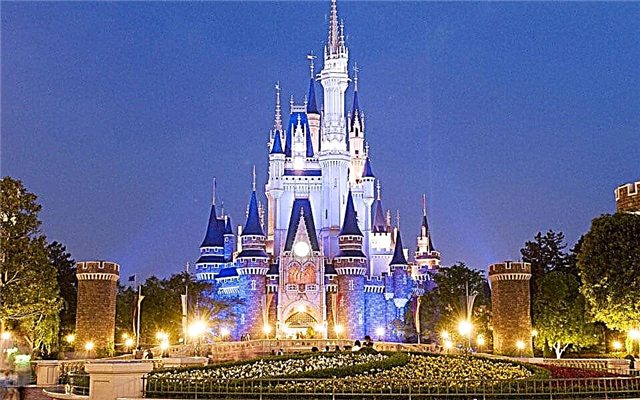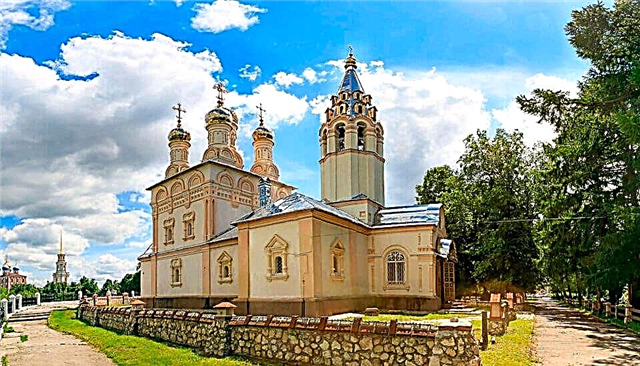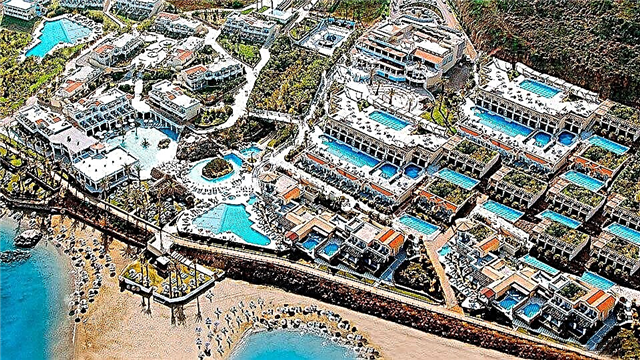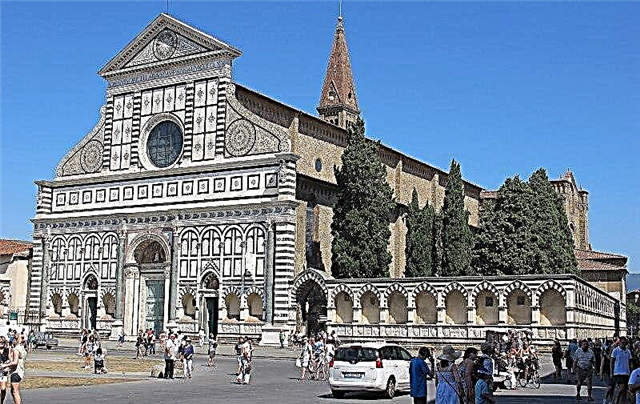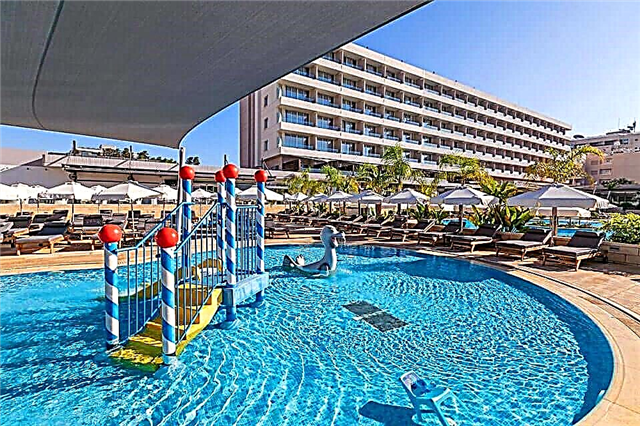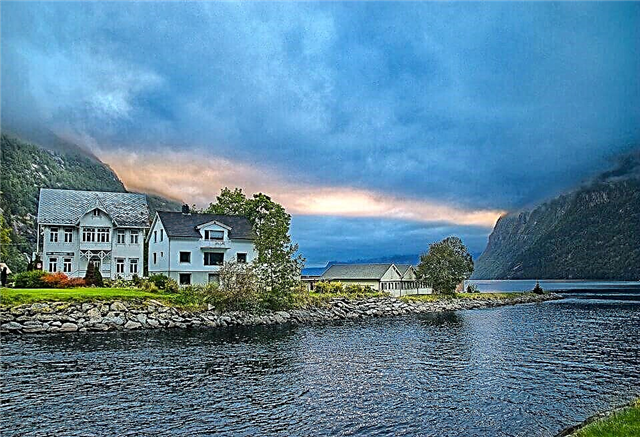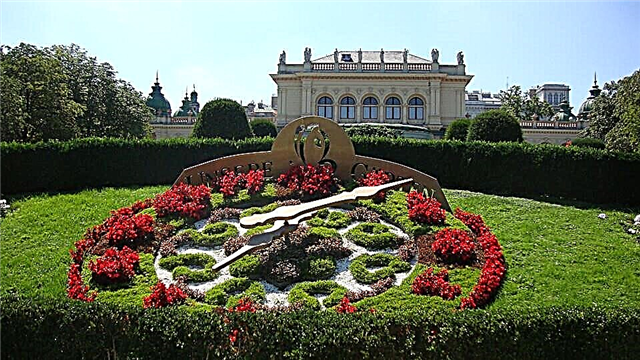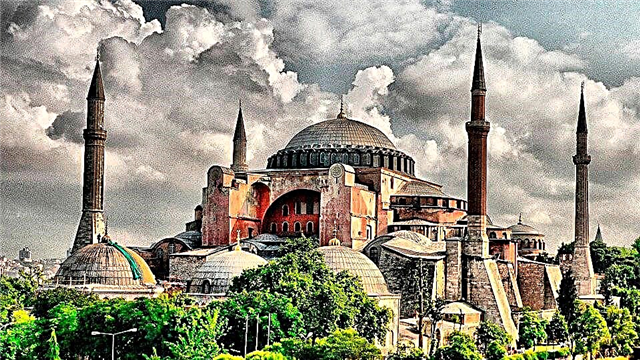The Turkish metropolis Istanbul, diverse and noisy, stretching along both banks of the Bosphorus Strait, was founded almost 3 thousand years ago. It was the capital of the Roman Empire called Constantinople in honor of the Emperor Constantine (330-395). For more than 1000 years the city served as the capital of the Byzantine Empire, and from the 15th century. became the center of the Ottoman Empire and later (until 1923) - Turkey. Istanbul, embodying the features of three world empires, is a huge museum of unique monuments of architecture, religion and culture. It takes a lot of time to get to know them. This recommendation article suggests what to see in Istanbul in 4 days and itinerary around the city.
How to get to the center on your own
As the old airport, Ataturk, could no longer cope with the increased passenger traffic, Istanbul New Airport (or IGA) began operating by order of the authorities. Built 50 km north of Istanbul, one might say, in an open field. There are no buildings or attractions around.
IGA will be fully completed in 2027. It is planned to receive 200,000,000 air passengers a year here. For this, the following will enter into service:
- 4 terminals
- 6 runways
- areas for simultaneous parking of 500 aircraft
The designers did not create a traditional airport, but a space object. The structures are built from modern composite materials. The Turkish authorities believe that the new airport will become the largest air gateway connecting the east and west. So far 1 terminal is operating in IGA. It occupies a huge territory, so it is not easy to move inside. For the convenience of guests, information signs and signs are installed in the hall.
There are several ways for guests to get from Istanbul New Airport to the city center:
- Taxi is the most convenient of them. The disadvantages are the high cost and dishonesty of some drivers. In order to avoid misunderstandings, you should book a trip in advance on one of the carriers' websites.
- Transfer. It is convenient and reliable, although the price is commensurate with a taxi ride.
- Bus service. An escalator leads from Terminal 1 to the parking lot. The buses are comfortable: they have a large luggage compartment, air conditioning. You should think about payment in advance. Special cards are sold at Istanbul New Airport. The disadvantage is inevitable traffic jams.
- High-speed shuttles. These are buses that carry passengers to Sultanahmet or Taksim without stopping. Unfortunately, even shuttles cannot avoid traffic jams.
- Rented car. It can be ordered in advance on the website or directly from Istanbul New Airport.
At the end of 2021, guests will be able to travel from Istanbul New Airport to the city center by metro.
Where to stay
If you do not want to overpay for food in restaurants and want to avoid a huge crowd of tourists, we recommend staying in one of the hotels or hostels in the area of Istiklal Street in Beyoglu. Here, mostly locals spend their free time in cafes and restaurants, so prices are lower than, for example, in the center. If you want to stay in close proximity to the main attractions, we recommend that you opt for the Sultanahmet area. Another of the most popular places to stay are Aksaray and Laleli. If you purchase a tour, the agent will most likely offer you accommodation in one of these areas.
Titanic city taksim
Just 5 minutes walk from Taksim Square
394 Reviews
based on Very good 8.3

Opera Hotel Bosphorus
Rooftop pool and restaurant
based on Very good 7.8

Swissotel The Bosphorus Istanbul
With stunning views of the Bosphorus
922 reviews
based on Very good 9.0

1 day
Once you find yourself in the center, you immediately feel the polyphony, city bustle and noise, crowdedness and diversity. Slender minaret towers alternate with avant-garde high-rises made of glass and concrete, ancient cathedrals with entertainment centers, old narrow streets with modern wide boulevards. A motley crowd of people "flows" in a multicolored stream in a stormy stream in different directions.
Saint Sophie Cathedral

Hagia Sophia (Hagia Sophia), in fact, is now a popular museum of Byzantine architecture, symbolizing the “golden age of Byzantium. For more than 1,000 years, the cathedral remained the most grandiose Christian church (537-1626). Built on the site of the former basilicas destroyed by fires, the cathedral was intended to symbolize the power of the Byzantine emperors.
The unique church was erected at the cost of painstaking daily work of 10 thousand people. The walls are decorated with white marble, delivered from the island of the same name, green marble columns - from the Ephesian temple of Artemis, porphyry columns - from the Roman Temple of the Sun. Several times the cathedral, which suffered from earthquakes, survived.
It was thoroughly plundered by the crusaders (1204), and after the conquest by the Ottomans, after partial reconstruction, it was transformed into a mosque - an undoubted decoration of the city and a popular tourist site. 4 minarets, a rich library, a madrasah, a shadyrvan make it in demand among local residents.
Blue Mosque

The modern cosmopolitanism of Istanbul is not able to overshadow the unique Islamic flavor, the symbol of which is a priceless architectural masterpiece captivating with beauty and grace of forms. The Blue Mosque, which attracts the eyes, is visible from afar - it is impossible to pass by it indifferently. The grandiose religious object was erected by order of Sultan Ahmed I as a sign of his plea for God's help in defeating his enemies.
The construction of a masterpiece made of precious stones and precious varieties of marble has been going on for 7 years. In the architectural style of the buildings, Byzantine and Ottoman features have merged, creating a unique appearance of the mosque. Virtuoso engineering solutions, the original decor of the building gave the right to call the project manager a jeweler. The prayer niche (mahrib) is hewn out of a monolithic piece of marble.
The walls and ceilings inside are decorated with highly artistic tiles of blue and white shades (20 thousand pieces), which gave the name of the mosque. The pulpit for prayers (minbar), also hewn from a single piece of marble, is covered with filigree carvings. Gold paintings, black and red ornament on the walls, magnificent stained-glass windows complement the rich and luxurious decoration.
Topkapi Palace
The pompous, majestic Topkapi Palace, built at the behest of Sultan Mehmed, was a luxurious haven for 25 Turkish sultans for 4 centuries. Covering an area of more than 170 hectares, it is the personification of the boundless power of the sultans and their countless riches. Under the first president of Turkey, who liberated the people from the power of the sultanate, the palace became a museum.
A massive entrance structure called the "cannon gate" (this is how the top kapa is translated) leads to the palace. Each entry or exit of the sultans was accompanied by a cannon shot, hence the name. In fact, it was a mini-state: mosques, hospitals, janissary barracks, workers and ceremonial offices.
The decoration of the palace amazes with its luxurious decoration and grandeur of 4 expositions-courtyards, introducing tourists to the life of the sultans. 1st courtyard - various service premises; 2nd - the Sultan's office, treasury; 3rd - the sultan's chambers, harem rooms; 4th - thematic pavilions. The exhibits include the richest collections of porcelain and jewelry.
Mosaic Museum

Excavations carried out in the 1920s. 20th century near the Blue Mosque, a platform was laid out among the ruins, surrounded by a destroyed colonnade (peristyle) - the remains of a Byzantine palace. The most valuable find was the mosaic covering (area 2 thousand sq. M), which adorned the palace and the gallery portico. Archaeologists were impressed by the extraordinary preservation of the mosaic and the artistic expressiveness.
A museum was organized at the excavation site (1953), which was first part of the Museum of Archeology, and then - the Museum of St. Sofia. The mosaic panel was “covered” with a wooden building, which poorly protects the rarity from humidity and temperature contrast. Then a stone building was built (1987), modernized in 2012 in order to better preserve the mosaics.
The virtuoso craftsmanship, incredible talent and painstaking labor of the ancient mosaic masters amaze the imagination and delight with maximum realism. Numerous plots of everyday and mythical themes widely introduce the life and worldview of prehistoric ancestors: feeding a baby, hunting, everyday affairs, mythological animals, etc. - 90 genres in total.
Bayezid Mosque

Located in the center of the historical part, the Bayezid Mosque is the 2nd largest domed mosque in the city, built at the direction of Sultan Bayezid II in the 16th century. instead of the Byzantine forum of Theodosius. During the demolition of the latter, all valuable materials: marble columns, colored stone, marble decorations were used in the construction of the religious complex. Since Bayezid conceived not just a mosque, but a whole complex, this also affected the unusual architecture of the building. The tall minarets are at a distance of 100 m from each other, in the appearance of the buildings, the early Ottoman and Western styles were mixed.
The central dome and 2 semi-domes on which it (the main dome) rests are equipped with a large number of windows (34). Massive porphyry columns support the domed group; the entire courtyard is lined with marble slabs. Now the buildings that were part of the religious complex have different purposes: a library is located in the former caravanserai and canteens, and a unique Museum of Calligraphy is located in the religious school. The remains of the Baezid are buried in one of the mausoleums. A book market is regularly held on the territory of the mosque, where tourists buy rare books.
Valens Aqueduct

Looking at the grandiose structure located in the district of Fatih, the Valens aqueduct, one involuntarily recalls Mayakovsky's catchphrase “worked by the slaves of Rome”. Traditional Roman aqueduct of colossal size, built in the 4th century. AD, shakes with its giant arches from gray stone. Named after the Emperor Valenta, under whom it was built, the aqueduct was an important part of the aqueduct of Constantinople. The length of the structure, made of gray stone taken from the walls of Chalcedon, was 1 km, its height was 26 m.
Everyone who has the opportunity to contemplate the monumental ancient structure is shocked by the technological capabilities of the ancient builders, who did not have any heavy vehicles. The excellent preservation of the arches and the fact that the aqueduct functioned until the 19th century is surprising. Now it is another symbol of the city.
Suleymaniye Mosque

The largest and second most important mosque, Suleymaniye, is located in the Vefa region, being its main decoration and famous landmark. The remains of Sultan Suleiman the Magnificent (the initiator of the construction) and his legendary wife Khyurrem (Roksolana) are buried within it.
According to legend, the architect Sinan, the author and executor of the project, exclaimed at the celebrations in honor of the opening of the object: "This mosque will stand forever!" The past centuries confirm his prophecy: the brainchild of Sinan, having survived 96 earthquakes, withstood almost without destruction. The architect fulfilled Suleiman's requirement to make the mosque seismically stable.
The basis of the mosque is a powerful foundation (60x57 m) with a reliable fastening system that does not allow the building to slide down the hill and is resistant to shaking. After the ditch was laid with stones, it was filled with water, for 3 years the foundation stood, forming a monolith, and then the walls were erected. 4 slender minarets, located in the corners, proudly look up, the ascetic beauty of the walls and domes delights and bewitches.
Rustem Pasha Mosque

A true gem among its "sisters", the Rustem Pasha Mosque is not as accessible to tourists as others, because it is located in a remote corner of the Old City. This is another brainchild of the architect Sinan (author Suleymaniye), his poetic touch in construction (1561-1562). All visitors leave the mosque in complete admiration.
A majestic domed building in the Ottoman style is erected on a square podium. Numerous entrance arches, vaults, columns and pillars that adorn the podium securely support the dome, decorated with lattice windows. Mighty gray walls bear the stamp of the past centuries and the hard work of thousands of workers embodied.
It is impossible not to freeze with delight, going inside the sanctuary - everything here is so beautiful and solemn, rich and artistic! The decoration of the walls with expensive Izmir tiles with floral patterns in white-blue, blue and brown tones amazes. The floor, finished with slabs of warm orange shades, seems to illuminate the space from below. Garlands of teardrop-shaped glass lamps adorn the top like raindrops.
2nd day
If after the first day of traveling around the city it seems to someone that everything interesting is already behind, then this will be a wrong opinion. It is worth having a good sleep, gain strength and continue exploring the unique sights of the heir of Constantinople. Walking around the city on the 2nd day will reveal new secrets of Istanbul, introduce you to more modern buildings, and allow you to get into the rhythm of life of the metropolis and its inhabitants.
Dolmabahce

In one of the most colorful districts of the city, there is the largest palace, more precisely, the Dolmabahce palace complex, striking the imagination with its beauty and size. Built in the middle of the 19th century. (1843-1856) as the new residence of the sultans, the palace symbolizes the unprecedented luxury and wealth of the Ottomans.
Sultan Abdulmejid I, intending to "surpass" the luxury of European monarchs, ordered to build a monumental palace in the Baroque style. A colossal amount of 5 million pounds in gold was spent on its construction. The decoration of the buildings required 14 tons of pure gold and 40 tons of silver.
Tourists who actively visit the architectural pearl of the city are amazed at the scale of wealth and luxury in the decoration of the palace buildings. They are surprised by the clock showing the same time - 9. O5 (the moment of Ataturk's death). Now the palace has been assigned the status of a museum and an object of national heritage, which in grandeur and beauty can compete with the outstanding palaces of the world.
Taksim

A modern type of high-speed movement around the city - an underground funicular, the entrance to which is located next to the Kabatash stop (tram - T 1), will allow you to quickly find yourself on Taksim Square. This is the legendary place of the city, associated with the most fateful events in the country, around which the famous sights of the city are located. It is here that the conditional border between the old part of the city and the new one is located.
“Taksim” means “distribution” in translation, since for many years the area served as a water distribution point for the city water supply system. In addition, many transport lines and tourist routes around the city originate from here. Celebrations, festive processions and protests have been and are being held here. Tourists are interested in the majestic monument of the Republic (1928), with sculptural images of Ataturk and his associates.
A visit to the Church of the Holy Trinity leaves a deep impression as an island of Orthodoxy in the Muslim faith. The pedestrian street starts from the square. Istiklal, ending with the ancient Galata Tower (a visiting card of Istanbul).
Istiklal

The former main avenue of Constantinople Grande Rue de Pera began to be called Istiklal ("independence") since 1928, when on the square. Taksim, the "Republic" monument was erected. Now a vibrant democratic life is in full swing here: crowds of tourists, local residents walk along numerous establishments, street musicians surprise with their skill.In the street infrastructure, at every step, you can feel the duality of Istanbul - the neighborhood of fashionable restaurants with unprecedented eateries, religious institutions with noisy nightclubs, Eastern style of architecture with Western style.
Although st. considered a pedestrian, a rare tram runs along it (since 1871), which is a tribute to tradition. Considering the huge flow of tourists, hundreds of hotels of various categories are open on Istiklal, from elite hotels to the cheapest hostels. There is a large selection of apartments, hotels with pools, spas.
Church of St. Anthony

This is not only the largest Catholic church in Istanbul, but also a real architectural masterpiece, captivating with its majesty and splendor. Built in 1911, the Catholic Church is a tribute to the local authorities for the Catholic faith, whose preachers were Franciscan monks.
The long-suffering history of the Franciscan monks, who first appeared in the city in 1221, is connected with the temple. The consequence of this was the erection in 1230 in the vicinity of the Galata district of the church of St. Francis (or St. Sophia). The temple was rebuilt 2 times after severe fires, and although it survived after the 3rd fire, it was turned into a mosque at the request of Sultan Mustafa II.
We must pay tribute to the monks, who persistently wanted to have their own temple, and who rebuilt the church, named after St. Anthony (1724). But she was destined for a sad fate - the laying of tram lines destroyed the creation of the monks. The church of St. Anthony, built in the style of neoclassicism, acquired a new life on 15.02.1912, when the first divine service took place. Today many parishioners from different countries gather here every day.
Galata tower

An ancient old resident - the Galata Tower, located on a high hill (140 m above sea level), is located in the Beyoglu district and is visible from all parts of the city. The tower, built in the 6th century, presumably under the Byzantine emperor Justinian as a wooden watchtower, in the 14th century. was rebuilt from stone. The dimensions of the stone giant, as if soaring above the waters of the Bosphorus, are impressive: height 65 m, diameter 16.5 m, thickness of walls 3.7 m. ...
After a strong earthquake (1503), which caused significant damage to Galata, it was restored and a superstructure was made. In the 17th century, when the inventor and the first aeronaut of Turkey, Hezafren Kulesi, flew across the Bosphorus on the wings he designed, starting from the top floor of the tower, it was called the Hezafren tower. For several centuries, a prison was located in the lower floors of the building, and the upper platform was an observation point.
Galata bridge

The unique ferry connecting the shores of the Golden Horn Bay - the Galata Bridge with a drawbridge cannot but amaze with its beauty and scale. A beautiful 2-storey bridge 142 meters wide stretches over the turquoise waters for 484 meters - the brainchild of the Turkish company STFA. The first wooden bridge arose in this place in 1845 at the behest of Walide, the wife of Sultan Mahmud II, after whom he was named. After serving 17 years, the structure fell into disrepair, and by the visit to Istanbul of Napoleon III (1863) the bridge was almost completely rebuilt.
A significant reconstruction of the Galata Bridge was carried out in 1875, after which the passage on it became toll. The current crossing is the fifth grandiose structure (1992-94). Today Galata Bridge is not only a popular crossing, but also a popular tourist attraction, where thousands of people come. 2nd floor - a busy transport line, which is used not only by cars, but also by trams. 1st floor - pedestrian and leisure area, where there are many different establishments.
Egyptian market

A special exotic touch in the picturesque panorama of the city is the Egyptian market or bazaar, which sells oriental spices. The market got this name because spices were delivered from India through Egypt, and the Egyptians traded them. According to history, a market also existed here in the Byzantine era. They began to build the Old Egyptian Bazaar from wood in 1660 as an object of sponsorship funding for the construction of the New Mosque, which has survived to this day.
Later, the market building, rebuilt from stone and brick, burned twice, and in 1940, during a major reconstruction, it acquired its modern look. The monumental L-shaped building has 6 arched entrances, and a lead dome crowns the roof. Even from a distance you can feel the intoxicating aroma of all kinds of spices, so it is difficult to make a mistake when looking for a bazaar. In addition to spices and herbs, dried fruits and dairy products are sold here.
Day 3
During the first 2 days of your stay, you learn so many interesting things that it seems that there is nothing more to be surprised at. But no, the ancient city located on 2 continents is capable of giving a lot of new impressions even on the 3rd day of traveling through it. The objects to be seen on the 3rd day will allow you to penetrate deeper into the history of the glorious past of the city, to feel its Byzantine authenticity. You will get acquainted with the legendary personalities who have contributed to the fate of the city.
Kariye Museum

In a remote area, there is an externally modest, but internally very meaningful building, the Kariye Museum. From a historical and cultural point of view, this is a real treasure of priceless rarities of the Byzantine period. The building was built in the 4-5th century. as the Church of Christ the Savior, which later served as the monastery of Chora. 2 times the rebuilt building in different eras changed its purpose: from a church it was transformed into a monastery and vice versa, then it served as a mosque.
The history of Byzantine Constantinople and Turkish Istanbul is embodied within the walls of the building. Under a layer of plaster, applied during the time of the Turks, artistic paintings by the Byzantines have been preserved. Nearby, the Temple Museum, officially opened in 1958, consists of 3 rooms, each of which amazes with amazing mosaics and frescoes. These are true masterpieces of Byzantine art from the 14th century, reflecting biblical subjects. The general decoration of the museum-church in beauty can compete with any other Byzantine temple in Europe.
Mosque Mihrimah Sultan

Next to the Kariye Museum is the Mihrimah Sultan Mosque - a beautiful architectural and religious monument with a romantic history. The mosque was named after the beloved daughter of Suleiman the Magnificent and Roksolana and was erected in her honor by the architect Sinan, who was in love with Mihrimakh. Many believe that the appearance of the mosque resembles the figure of a girl in a long robe. This similarity is created by 2-tiered porticos at the base of the building and under the domes.
The central dome, crowning the mosque, smoothly transitions to the lower domes. Daylight plays a special role here, penetrating into the halls and creating an unprecedented impression, reflected on the stained-glass windows and openwork walls. Around the mosque there is a rumor about its heavenly connection on the birthday of Mihrimah, March 21. It is believed that if you stand on this day between 2 mosques (the 2nd is located in the district of Edirnekapi), then the Moon and the Sun will be visible between the minarets at the same time. The mosque is highly revered by the locals.
Walls of Constantinople

The remains of powerful fortress walls and towers are a unique architectural monument, a vivid reminder of Byzantine Constantinople, of its former greatness. They are otherwise called Theodosius walls, because they were built on the initiative of the emperor Theodosius II (408-413), when the city expanded beyond the borders.
After standing for 3 centuries, the walls were partially destroyed by a strong earthquake in 747, but rebuilt and reinforced with an additional ditch.
After the conquest of the city by Mehmed (1453), the damage to the walls of Constantinople was repaired. But in the 19-20 century. the fortification began to be dismantled as unnecessary.Assessing the historical and cultural significance of the monument, the public took the walls under the protection of UNESCO, in the 80s of the 20th century. they have been restored. Although the earthquakes of recent years have significantly damaged the new masonry, we have the opportunity to see symbols of the power of Byzantium.
Hill and coffee house Pierre Loti

This iconic place is located in the Eyup district, on a large hill of the former Ottoman cemetery. The top of the hill is a kind of observation deck, which offers stunningly beautiful views of the bay and the city. You can climb it on foot or by cable car. The enterprising owner, who opened a cafe in this picturesque place surrounded by slender cypresses, named the coffee establishment after the popular in the 19th century. writer Pierre Loti. This is the pseudonym of the French naval officer Louis M.J. Vio, who described in his works the countries he visited.
Loti's novels, dedicated to the life of the ancient, mysterious East, its traditions deeply worried readers, and the cafe named after him attracted many visitors. Now it is also not empty - hundreds of tourists on the way inspect the surroundings with marble tombstones, admire the views of the Golden Horn, then drink apple tea and coffee in Pierre Loti's cafe.
Day 4
A lot of interesting impressions are left by the 4th day of exploring the city, which connected East and West, embodied the richest history of 2 empires. A visit to the Archaeological Museum, the Ottoman fortress, the original basilica and the grand bazaar will impress.
Rumeli Hisary Fortress

The historic fortress of Rumeli Hisary, striking in its scale, was erected in 1452 by order of the padishah Mehmed (the Conqueror) as a strategic structure for the siege of Constantinople. builders and 1,000 designers erected powerful walls and towers in 4.5 months to "cut off" the city from the sea. The foundation of Rumeli was the foundation of the destroyed ancient Byzantine fortress Foneus, on which walls 7 m thick were erected, 3 huge main towers with gates and 13 small ones connecting the 2nd row of walls. Soldiers' barracks and a mosque were built in the courtyard (only the minaret has survived from it).
In the 17th century. the fortress lost its strategic importance and began to be used as a prison, which came to be called the "castle of oblivion." In the 50s of the last century, the fortress was restored, the Artillery Museum, the Summer Theater were organized in it and opened to the public.
Archaeological Museum

The Museum of Archeology at the time of its creation was called the “Museum of Sarcophagi” (they became its first exhibits). The first building of the neoclassical style in the city became a museum in 1896. With the advent of many other artifacts, 2 more buildings were built, and today they are 3 thematic museums. Not all museums in the world can boast of so many unique, authentic exhibits reflecting different eras of our times. e. in the development of mankind.
Priceless finds of excavations carried out in Istanbul, Africa, Afghanistan, the Balkans have found their place in the Archaeological Museum, in the pavilion of the Ancient East and the Tiled Pavilion. The sarcophagi of A. Macedonian or royal ones are the most significant artifacts brought from Ancient Syria. Here are kept the mummies of the pharaohs of Egypt, fragments of sculptures from the ancient Greek temples of Zeus and Athena, a collection of cuneiform texts, Ottoman coins and much more.
Basilica Cistern
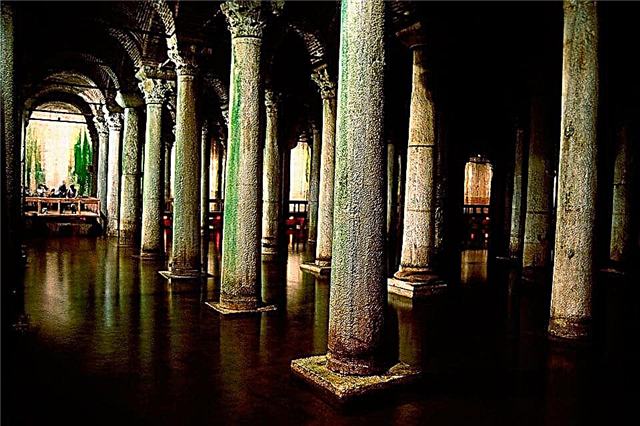
If it seems to someone that there is nothing to be surprised at, then he will be mistaken if he has not yet visited an absolutely unique structure - the Basilica cistern. This former reservoir (as "cistern" is translated) is a technological and architectural miracle, worked out under the Emperor Justinian. When there was no need for a reservoir, the Yerebatan Saray was opened in this unique room, that is, an underground palace that has become an interesting museum. There is no limit to the admiration of tourists for the craftsmanship of the Byzantine builders as they descend here.
The gigantic hall is filled with 336 8-9-meter marble columns supporting the ceiling. They were mainly taken from ancient temples, which is noticeable in their processing. The most notable of them are 2 columns, the bases of which are decorated in the form of the heads of Medusa the Gorgon. The original lighting of the room creates a truly magical atmosphere.
Grand Bazaar and Chamberlitas

One of the most visited by tourists, the Chemberlitash district is known for the Column of Constantine, hamam baths, the eponymous square and the Grand Bazaar. The first column with a statue of the emperor was installed in 330, the last - 2 centuries later. Turkish hammams, now famous all over the world, have a special flavor here.
The old covered market appeared on this place even under Mehmed the Conqueror in 1453. Repeatedly rebuilding and expanding, the Grand Bazaar turned into the main center of trade and business and even the slave trade (until the 19th century).
At the beginning of 17 on the territory of the market there were 67 streets, 5 mosques, 7 fountains, 18 gates. This huge market complex cannot be called otherwise than an oriental fairy tale. Having come here for an hour, you can stay here for half a day - the market space is so colorful, bright, beautiful and diverse. It seems that his pavilions have everything you want - the range of goods is off the charts. You should not demonstrate your well-being here, you must definitely bargain when buying.

